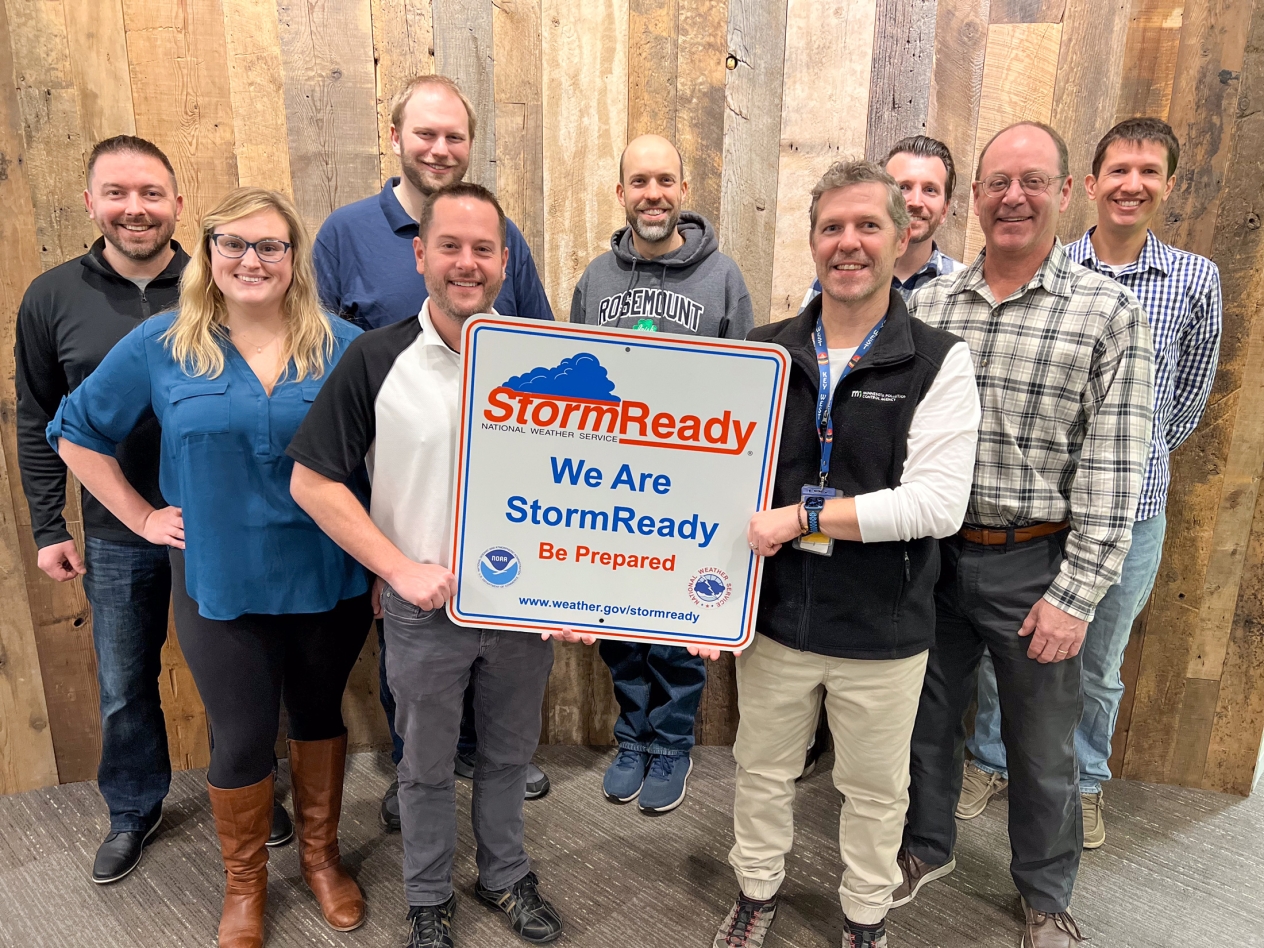
The National Weather Service (NWS) deemed the MPCA StormReady, making it the first state agency in Minnesota to receive this designation. MPCA meteorologists Daniel Dix and Matt Taraldsen received this honor after NWS officials toured the facility in December.
It’s an important distinction, according to Dix, because it reflects the agency’s commitment to keep all Minnesotans safe, not just agency staff. The StormReady designation recognizes the agency’s commitment to emergency management planning and continuity of operations during an emergency. What that means for Minnesotans is that the MPCA has the ability to continue its business uninterrupted in case of an emergency.
“The desire is to build a weather-aware culture in the agency,” Dix says. “Our team is also proud to help other agencies accomplish the same culture among their staff, too. In fact, we’ve provided winter weather training to five other state agencies.”
That weather-aware culture goes far beyond the well-established air quality alerts that the MPCA issues based on current air quality conditions. It provides critical information that empowers staff to make their own decisions regarding safety ahead of dangerous lightning, hail, or winter storms.
Partnership and progress towards StormReady
The preparedness work has been advancing since 2015, when the MPCA began the work for the Weather-Ready Nation Ambassador designation, which came in 2017. The Weather-Ready Nation Ambassador initiative is reserved for community leaders who amplify and expand the reach of NWS messaging, with the goal of creating better-prepared and more resilient communities. Ambassadors promote safety messaging and collaborate with the National Oceanic and Atmospheric Agency and the NWS.

In 2021, the MPCA was recognized as an Ambassador of Excellence within the Weather-Ready Nation Ambassador initiative because of the agency’s strong partnership and open communication with the NWS.
The StormReady designation came after MPCA staff provided a tour of the agency’s Emergency Operations Center (EOC) to NWS staff in December 2023. The agency’s EOC can be set up in under an hour and helps ensure a continuity of operations within the agency during emergencies. It’s a major component of the StormReady designation. Other criteria include having multiple ways to receive and alert the staff and public about severe weather warnings, having a system that monitors local weather conditions, and having a formal hazardous weather plan, which includes training severe weather spotters.
The EOC
The EOC, located in the MPCA’s lower-level training room in Saint Paul, has the ability to display a lot of information at once. Weather data and direct communications with the NWS is only part of it. A web-based system connects the EOC to Minnesota Homeland Security and Emergency Management, allowing several different operations to be monitored and managed simultaneously. The EOC also provides access to Federal Emergency Management Agency tools, internal GIS tools, information sites, and Microsoft Teams to facilitate virtual meetings. It also includes redundant phone systems and 800 MHz radios ready for deployment.
“This EOC is important for public safety,” Dix says. “The agency’s setup allows MPCA to either assist or lead in emergency events that have high impacts to the public or environment. It also maximizes coordination with other government agencies.”
The EOC facility can accommodate up to 15 people. Staff in Saint Paul or regional offices can also join virtually from almost anywhere.
Resiliency and continuity
A lot of work has gone into making the MPCA a resilient organization. Critical systems and data are housed off-site and are securely stored to ensure agency operations can continue through any emergency.
“This (continuity plan) ensures that critical functions continue with as little interruption as possible,” Dix says. “It’s important to note that the state’s emergency operations plan for hazardous waste and related incidents dictates that MPCA serve as the lead agency, but our agency will also assist others as needed.”

The NWS values partners that continue to function during an emergency as the MPCA has demonstrated. This ongoing partnership was recognized in January at the American Meteorological Society meeting, where Dix presented MPCA’s path to becoming StormReady. Dix highlighted the agency’s leadership and partnership with other state agencies as well as safety campaigns for staff. The StormReady designation demonstrates the leadership Dix provides, according to a senior forecaster with the NWS office in Chanhassen.
“Our main partnership (with MPCA) has to do with getting word out about air pollution, but we depend on other agencies to get the word out when it comes to public safety,” says NWS Warning Coordinator Todd Krause. “MPCA relays information about weather safety and active weather where people need to respond. All the safety training that goes in beforehand is helpful once we do have an adverse weather condition.”
The designation may be a pinnacle in preparedness, but it is not the end of the journey. MPCA meteorologists will continue the annual traditions of educating staff about weather hazards, including training more storm spotters, adding to the 100-plus MPCA staff who have been trained over the year. They will also continue working with all six NWS offices covering each corner of Minnesota to inform and protect colleagues and all Minnesotans.
